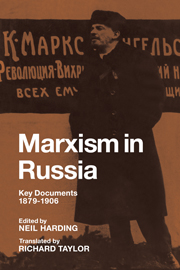Book contents
- Frontmatter
- Contents
- Acknowledgements
- Preface
- Introduction
- DOCUMENTS
- Section 1 1879–1893: theoretical foundations and worker projects
- Section 2 1894–1897: bridges to the workers – economic agitation
- Section 3 1898–1902: political agitation and the critics of orthodoxy
- Section 4 The Bolshevik/Menshevik dispute – organisational questions and appraisals of the 1905 revolution
- Notes
- List of sources
- Guide to further reading
- Glossary
- Index
Section 2 - 1894–1897: bridges to the workers – economic agitation
Published online by Cambridge University Press: 05 November 2011
- Frontmatter
- Contents
- Acknowledgements
- Preface
- Introduction
- DOCUMENTS
- Section 1 1879–1893: theoretical foundations and worker projects
- Section 2 1894–1897: bridges to the workers – economic agitation
- Section 3 1898–1902: political agitation and the critics of orthodoxy
- Section 4 The Bolshevik/Menshevik dispute – organisational questions and appraisals of the 1905 revolution
- Notes
- List of sources
- Guide to further reading
- Glossary
- Index
Summary
15. THE WORKING DAY (1894)
Anon.
We all know very well what it means to be a worker: it means above all else to labour and to labour hard! Hard and long. The tailor, the cobbler, the locksmith, the factory worker – life is not easy for any of them. Working a machine, sitting doubled up over a bench, wielding a heavy hammer, using a plane – and doing this not for an hour, a day, a month, or even a year, but for your whole life. Yes, the worker's lot is a sad one! It is not, therefore, surprising that the workers are constantly complaining about their miserable fate. In doing so, they observe: it is true that life is hard but what can we do? Can anything be done? We have to eat and drink somehow, after all, and we have to earn our bread: nobody gives us anything for nothing – so how could things be different?
Thus, the constant worry about our daily bread deprives us of the opportunity to review our position and discuss it properly. In isolation, the individual worker devotes little time to considering whether his working conditions could be alleviated in any way or whether, if he has to work, only reasonable and acceptable demands should be made of him.
Yes, reasonable! But, of course, if we reduce the scale of our labour, we shall have nothing to live on.
- Type
- Chapter
- Information
- Marxism in RussiaKey Documents 1879–1906, pp. 121 - 220Publisher: Cambridge University PressPrint publication year: 1983



